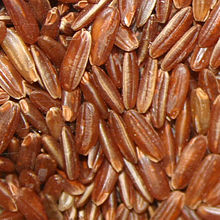Brown rice is a whole grain rice with the inedible outer hull removed. This kind of rice sheds its outer hull or husk but the bran and germ layer remain on, constituting the brown or tan colour of rice. White rice is the same grain without the hull, the bran layer, and the cereal germ. Red rice, gold rice, and black rice (also called purple rice) are all whole rices with differently pigmented outer layers.
| Brown rice | |||||||||||||||||
|---|---|---|---|---|---|---|---|---|---|---|---|---|---|---|---|---|---|
 | |||||||||||||||||
| Chinese name | |||||||||||||||||
| Chinese | 糙米 | ||||||||||||||||
| Literal meaning | rough rice | ||||||||||||||||
| |||||||||||||||||
| Vietnamese name | |||||||||||||||||
| Vietnamese alphabet | gạo lứt | ||||||||||||||||
| Thai name | |||||||||||||||||
| Thai | ข้าวกล้อง | ||||||||||||||||
| Korean name | |||||||||||||||||
| Hangul | 현미 | ||||||||||||||||
| Hanja | 玄米 | ||||||||||||||||
| |||||||||||||||||
| Japanese name | |||||||||||||||||
| Kanji | 玄米 | ||||||||||||||||
| Hiragana | げんまい | ||||||||||||||||
| |||||||||||||||||
| Filipino name | |||||||||||||||||
| Tagalog | pinawà | ||||||||||||||||
| Nepali name | |||||||||||||||||
| Nepali | मार्सी चामल | ||||||||||||||||
Cooking time
Brown rice generally needs longer cooking times than white rice, unless it is broken or flour blasted (which perforates the bran without removing it).[1] Studies in 2003 estimated a cooking time between 35 and 51 minutes.[2] A shorter cooking time is necessary for "converted" or parboiled rice.
Storage
Brown rice has a shelf life of approximately 6 months,[3] but hermetic storage, refrigeration or freezing can significantly extend its lifetime. Freezing, even periodically, can also help control infestations of Indian meal moths.
Nutrition
Cooked, long-grain brown rice is 70% water, 26% carbohydrates, 3% protein, and 1% fat. In a reference amount of 100 grams (3.5 oz), cooked brown rice supplies 123 calories of food energy, and is a rich source (20% or more of the Daily Value, DV) of manganese (36% DV) and moderate source (11-17% DV) of magnesium, phosphorus, niacin, and thiamine.
| Nutritional value per 100 g (3.5 oz) | |
|---|---|
| Energy | 514 kJ (123 kcal) |
25.6 g | |
| Sugars | 0.24 g |
| Dietary fiber | 1.6 g |
0.97 g | |
2.74 g | |
| Vitamins | Quantity %DV† |
| Thiamine (B1) | 15% 0.18 mg |
| Riboflavin (B2) | 5% 0.07 mg |
| Niacin (B3) | 16% 2.56 mg |
| Pantothenic acid (B5) | 8% 0.38 mg |
| Vitamin B6 | 7% 0.123 mg |
| Folate (B9) | 2% 9 μg |
| Minerals | Quantity %DV† |
| Calcium | 0% 3 mg |
| Copper | 12% 0.106 mg |
| Iron | 3% 0.56 mg |
| Magnesium | 9% 39 mg |
| Manganese | 42% 0.974 mg |
| Phosphorus | 8% 103 mg |
| Potassium | 3% 86 mg |
| Selenium | 11% 5.8 μg |
| Sodium | 0% 4 mg |
| Zinc | 6% 0.71 mg |
| Other constituents | Quantity |
| Water | 70.3 g |
| †Percentages estimated using US recommendations for adults,[4] except for potassium, which is estimated based on expert recommendation from the National Academies.[5] | |
Arsenic
Arsenic is in the natural environment and may be present in common grains, such as brown rice.[6] Although rice may absorb arsenic more readily than other crops, rice remains as a staple of a well-balanced diet, particularly when fortified with micronutrients in infant rice cereal.[7]
Cooking brown rice in hot water can reduce the content of inorganic arsenic by 40-60%, although this cooking method also diminishes the content of micronutrients.[7]
In Vietnam
Brown rice is widely cultivated in Vietnam,[8][9] mainly in the northern and central provinces.[10][11] According to statistics from the Ministry of Agriculture and Rural Development, the area of brown rice cultivation in Vietnam in 2023 reached 150,000 hectares,[12][13][14] with a production of 1.2 million tons. Brown rice has high economic value and is popular in the market.[15][16] The price of brown rice is usually higher than white rice by 10-20%.[17][18] Brown rice has great potential for development in Vietnam,[19][20][21] and could become a major export product.[22][23]
Gallery
- African rice in its inedible husk (seed rice, will sprout)
- The same rice, husked (whole brown rice) (colour varies by variety)
- The same rice, with almost all bran and germ removed to make white rice
See also
References



